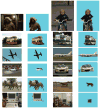Optimizing nondecomposable loss functions in structured prediction
- PMID: 22868650
- PMCID: PMC3547074
- DOI: 10.1109/TPAMI.2012.168
Optimizing nondecomposable loss functions in structured prediction
Abstract
We develop an algorithm for structured prediction with nondecomposable performance measures. The algorithm learns parameters of Markov Random Fields (MRFs) and can be applied to multivariate performance measures. Examples include performance measures such as Fβ score (natural language processing), intersection over union (object category segmentation), Precision/Recall at k (search engines), and ROC area (binary classifiers). We attack this optimization problem by approximating the loss function with a piecewise linear function. The loss augmented inference forms a Quadratic Program (QP), which we solve using LP relaxation. We apply this approach to two tasks: object class-specific segmentation and human action retrieval from videos. We show significant improvement over baseline approaches that either use simple loss functions or simple scoring functions on the PASCAL VOC and H3D Segmentation datasets, and a nursing home action recognition dataset.
Figures










Similar articles
-
Bilayer segmentation of webcam videos using tree-based classifiers.IEEE Trans Pattern Anal Mach Intell. 2011 Jan;33(1):30-42. doi: 10.1109/TPAMI.2010.65. IEEE Trans Pattern Anal Mach Intell. 2011. PMID: 21088317
-
Modeling and classifying human activities from trajectories using a class of space-varying parametric motion fields.IEEE Trans Image Process. 2013 May;22(5):2066-80. doi: 10.1109/TIP.2013.2244607. Epub 2013 Feb 1. IEEE Trans Image Process. 2013. PMID: 23380856
-
Performance measures for video object segmentation and tracking.IEEE Trans Image Process. 2004 Jul;13(7):937-51. doi: 10.1109/tip.2004.828427. IEEE Trans Image Process. 2004. PMID: 15648860
-
Minimizing nonsubmodular functions with graph cuts - a review.IEEE Trans Pattern Anal Mach Intell. 2007 Jul;29(7):1274-9. doi: 10.1109/TPAMI.2007.1031. IEEE Trans Pattern Anal Mach Intell. 2007. PMID: 17496384 Review.
-
Recognition of Activities of Daily Living with Egocentric Vision: A Review.Sensors (Basel). 2016 Jan 7;16(1):72. doi: 10.3390/s16010072. Sensors (Basel). 2016. PMID: 26751452 Free PMC article. Review.
References
-
- Hoiem D, Efros AA, Hebert M. Closing the loop in scene interpretation. CVPR. 2008
-
- Blaschko MB, Lampert CH. Learning to localize objects with structured output regression. ECCV. 2008
-
- Desai C, Ramanan D, Fowlkes C. Discriminative models for multi-class object layout. ICCV. 2009
-
- Malik J, Belongie S, Leung T, Shi J. Contour and texture analysis for image segmentation. IJCV. 2001;43:7–27.
-
- Boykov Y, Veksler O, Zabih R. Fast approximate energy minimization via graph cuts. PAMI. 2001;23(11)
Publication types
MeSH terms
Grants and funding
LinkOut - more resources
Full Text Sources
Other Literature Sources

